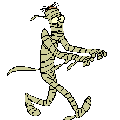
Korean Mummy Holds Clues to Disease
The liver of a child mummy preserved for 500 years still holds samples of the hepatitis B virus.
The mummy, along with others recently unearthed in South Korea, will help scientists understand how the virus evolved to its present state and what to expect in the future.
"This is a 'know your enemy' expedition to see if we can get information that can help today's—and tomorrow’s—sufferers," said Mark Spigelman of the Kuvin Center for the Study of Infectious and Tropical Diseases at the Hebrew University of Jerusalem. Spigelman is a paleo-epidemiologist, who studies ancient diseases found on mummified bodies to shed light on the modern forms of such illnesses.
It has some down further in the article on the mummification process itself:
Mummification, which prevents the body from decaying naturally, would seem to go against Koreans' ancient tradition of ancestor worship and the belief that upon death the soul rises up and the body returns to its natural components. However, in 1392, a group called the Neo-Confucianists took over, revising former burial practices.
The newer burial practice favored mummification. It involved laying the body on ice for up to 30 days and then placing the body inside a pine coffin buried in a lime soil mixture. Compounds have been found in pine with anti-fungal and anti-bacterial properties that likely put the brakes on decay of the bodies.
Not sure of that last bit. I wonder if putting the body on ice does most of the work by freeze-drying it.